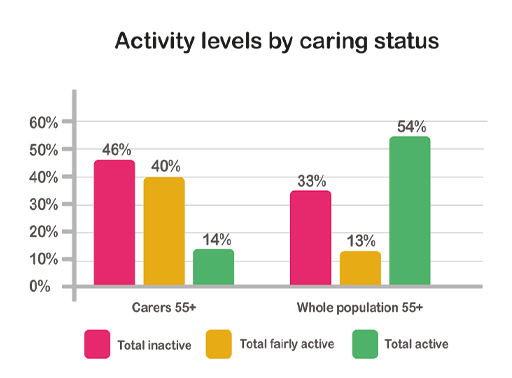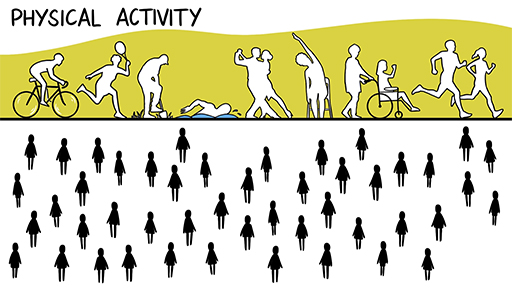3 Physical activity in the caring role
Despite the known benefits of physical activity to physical and mental health, in the 12 months to November 2019, almost 1 in 4 women and 1 in 5 men were classified as ‘inactive’ (i.e. being physically active for less than 30 minutes on average per week) in the UK (NHS Digital, 2020). Furthermore, physical inactivity has been cited as the fourth largest cause of disease and disability in the UK (Public Health England, 2014).
At the time of writing, no research reports on the actual prevalence of physical activity across the caring population in the UK (Horne et al., 2021), although 54% of carers report to have reduced the amount of exercise they do because of caring (Carers UK, 2017). Data examining carers over the age of 55 years indicates a concerning picture with a clear difference evident between the physical activity levels of the caring and non-caring population in this age group (Carers UK, 2020; Figure 3).

It should be highlighted that the inactivity levels shown in Figure 3 are not the result of carers not wanting to be physically active. 81% of carers of all ages report that they are not able to do as much physical activity as they would like (Carers UK, 2019). However, given the physical and mental health impacts of caring discussed in Session 1, Activity 2 and the proven benefits of physical activity, it is particularly important for carers to be physically active, making it vital to explore any potential barriers to this.
Activity 4
Watch Video 2 below. As you watch, consider your own physical activity levels and the correlates that might influence this. If you are a carer, reflect on any barriers that you face. If you are not a carer, think back to the case studies in Session 1 – what might be the barriers to physical activity that they face?

Transcript: Video 2
Discussion
When reflecting on your own physical activity levels and influencing correlates, you might have identified a number of barriers that you, or one of the case study carers, might face. For example, when considering social correlates, it might be that those around you (or the carer) might not be physically active which might not encourage you (or the carer) to be physically active.
Dr Jo Horne (who narrated Video 2) and colleagues (2021) reviewed the research literature to examine the barriers and facilitators to physical activity of carers based in the UK. The findings of the review highlighted the following barriers:
- increasing age
- not wanting to leave the caree alone
- the caree being unable to take part in activities
- health conditions
- fatigue
- lack of time
- difficulties in changing the routine for the caree.
You might have identified some of the barriers on this list when reflecting on your own physical activity levels or that of the case studies from Activity 2 in Session 1.
The facilitators to physical activity in carers found in the research are discussed in the next section.
Despite the challenges that a carer could face to be physically active, the evidence of the benefits for being active is strong. The next section looks at considerations for carers to become more physically active.
